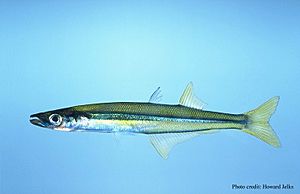Brook silverside facts for kids
Quick facts for kids Brook silverside |
|
|---|---|
 |
|
| Conservation status | |
| Scientific classification | |
| Synonyms | |
|
Chirostoma sicculum Cope, 1865 |
The Brook Silverside (scientific name: Labidesthes sicculus) is a small fish found in North America. It belongs to a group of fish called Neotropical silversides. These fish live in slow-moving rivers and lakes. You can find them from the Great Lakes all the way to the Mississippi Basin and the Gulf Coastal Plains.
Brook Silversides like clear water with lots of underwater plants. They eat tiny water creatures called copepods, young insects (larvae), and flying insects. They lay their eggs in the spring and early summer. Sadly, many freshwater fish like the Brook Silverside are in danger. To help them survive, we need to keep their natural homes clean and clear.
Contents
Where Do Brook Silversides Live?
Brook Silversides live across a wide area in North America. Their homes stretch from the Great Lakes down through the Mississippi Basin and the Gulf Coastal Plains. This includes 27 U.S. states and parts of Canada. They naturally live in most of these places. Sometimes, people have moved them to new areas. This was done so larger sport fish would have more food to eat.
These fish prefer freshwater lakes, ponds, calm pools, and small rivers. They can live in both cool and warm water. The amount of plant life and how fast the water moves can change. But one thing is always true: Brook Silversides love clear water. They do not like water with a lot of dirt or particles floating in it. This kind of cloudy water is called turbid water. For example, in Tennessee, Brook Silverside numbers went down after a big waterway was built. This likely happened because new fish came in and competed for food.
What Do Brook Silversides Eat?
Brook Silversides are an important part of the food chain. Many larger fish eat them. Their main diet is tiny water animals called zooplankton. They are very picky eaters! About 80% of their diet is tiny crustaceans called cladocerans. They also eat small flying insects (40%) and midge larvae (20%).
What they eat can change as they grow older and with the seasons. When they are very young, they might eat smaller fish. As they get older, their diet shifts to young insects. In winter, they mostly eat tiny crustaceans that float in the water. Sometimes, new fish species are introduced to their habitat. This can make it harder for Brook Silversides to find food. For example, a fish called Menidia audens was introduced. It competes with the Brook Silverside for the same food. This competition has caused Brook Silverside numbers to drop.
How Do Brook Silversides Grow and Reproduce?
Brook Silversides breed in the summer, from late May to mid-August. They have a very short life, usually only one year. In their first year, they grow very quickly. They can grow up to one millimeter each day! They quickly reach their full size, which is about eight centimeters long. By their first summer, they are ready to reproduce.
When they lay their eggs, the eggs have a special string attached. This string helps the eggs stick to logs, plants, and rocks. The water temperature does not decide if a fish will be male or female. After the eggs hatch, the baby fish immediately swim away from the shore. They go into deeper water but stay just under the surface. They often swim together in large groups called schools. Brook Silversides move around a lot during their lives. Human changes to their environment seem to affect their numbers more than their natural behaviors.
Protecting Brook Silversides
Many freshwater fish, including the Brook Silverside, are in danger. This is due to human actions like introducing new species, changing habitats, pollution, and building projects. Most fish extinctions in the group called ray-finned fishes are freshwater species. To help these fish survive and increase their numbers, we need to stop building more dams or waterways.
It is also very important to stop pollution. Water running off farms can make rivers cloudy and dirty. Brook Silversides cannot live well in this kind of water. Groups like the USFWS and TVA regularly check streams. This helps them keep an eye on fish populations and control water quality. Over-fishing and different fish types mixing are not big problems for Brook Silversides. The biggest threats are new species and losing their natural homes. Some areas are being set aside to protect native fish. But more work is still needed to keep these amazing fish safe.
See also
 In Spanish: Pejerrey de arroyo para niños
In Spanish: Pejerrey de arroyo para niños



